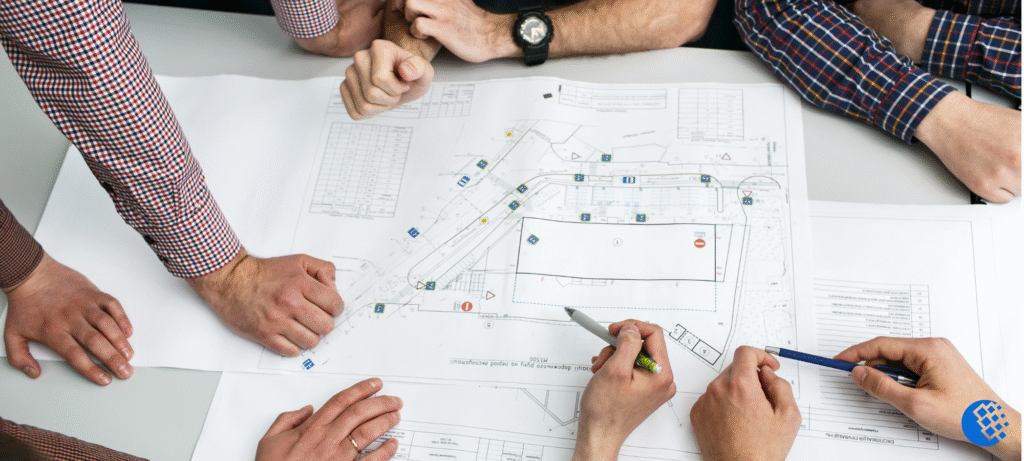The Art of Building Beyond Blueprints
In the world of construction, success doesn’t begin with the first brick it begins with a vision. Every skyscraper, bridge, or housing project starts as an idea that must be transformed into something tangible, reliable, and enduring. This transformation requires more than physical strength or engineering precision; it demands smart planning the thoughtful orchestration of time, talent, and technology.
Today’s construction industry is not just about creating structures; it’s about building smarter. Whether it’s managing large-scale developments or residential projects, effective planning defines whether a project meets deadlines, stays within budget, and ensures safety and quality at every stage. When vision meets structure, smart planning is the bridge that connects creativity with execution.
Laying the Foundation: What Smart Planning Really Means
In the past, construction planning often relied on manual schedules, fragmented data, and reactive decision-making. Teams would spend hours tracking progress on spreadsheets or trying to align contractors and suppliers through endless phone calls. Delays, miscommunication, and cost overruns were almost inevitable.
Smart planning has changed that narrative. It combines data, foresight, and collaboration to build a system where every decision is proactive rather than reactive. Modern construction management now integrates digital project tracking, predictive modeling, and automation — allowing teams to anticipate problems before they occur. The goal is simple: minimize uncertainty and maximize efficiency.
When done right, smart planning transforms construction from a sequence of disconnected tasks into a coordinated ecosystem where every team member understands their role, timeline, and contribution to the bigger picture.
Cost Estimation: The Financial Blueprint
Before a single machine moves or a foundation is poured, one question shapes the entire project: How much will it cost?
Cost estimation is not merely a budgeting exercise, it’s the strategic backbone of every construction plan.
Accurate estimation helps predict material requirements, labor needs, and equipment usage with precision. It enables decision-makers to allocate funds wisely, assess project feasibility, and prepare for contingencies. A miscalculation at this stage can ripple through the entire project, causing delays or financial strain down the line.
Modern cost estimation relies on technology to improve accuracy and speed. Digital estimating tools and Building Information Modeling (BIM) systems integrate real-time data from suppliers, historical projects, and market rates. This allows estimators to generate detailed projections within minutes projections that adapt as the project evolves.
For example, when material prices fluctuate or design changes occur, these tools instantly update cost forecasts, keeping the financial side of construction transparent and under control.
But the true value of cost estimation isn’t just precision it’s insight. When planners understand cost behavior over time, they can make smarter decisions about procurement, resource allocation, and risk management. In this way, cost estimation becomes less about numbers and more about strategic foresight.
Labour Management: The Human Core of Every Project
If cost estimation defines what’s possible, labour management defines how it’s achieved. Construction is one of the most human-centric industries where people’s skills, coordination, and motivation directly influence success.
Managing a construction workforce is no small task. Every day on-site involves multiple roles — engineers, supervisors, technicians, and skilled laborers each with unique responsibilities and challenges. Smart labour management ensures the right people are at the right place, doing the right task, at the right time.
Modern planning systems simplify this complex coordination. Digital scheduling tools now track attendance, skill sets, and productivity in real-time. Project managers can view who’s available, which teams are overworked, and where gaps exist allowing them to balance workloads effectively. This reduces idle time and minimizes the risk of burnout or human error.
Beyond efficiency, labour management is also about safety and morale. A well-planned shift schedule, proper communication channels, and timely feedback create a sense of structure and accountability on site. When workers feel valued and informed, productivity follows naturally.
Smart planning, therefore, doesn’t just organize people it empowers them.
Technology: The Bridge Between Vision and Execution
The construction industry has entered an era where technology and planning are inseparable. From project design to delivery, digital tools bring precision and predictability to a field once dominated by uncertainty.
Software platforms now centralize all aspects of construction planning budgeting, procurement, scheduling, and resource tracking into a single interface. Project managers can monitor site progress, compare estimated vs. actual performance, and adjust strategies in real time.
Some construction companies even invest in custom software solutions tailored to their operational needs. These platforms integrate modules for cost estimation, workforce management, inventory tracking, and compliance ensuring that every piece of data is connected.
The result is a more agile construction environment, where teams make decisions based on insights rather than intuition.
Smart technology is not just an upgrade; it’s a strategic advantage that allows construction businesses to stay competitive, deliver faster, and maintain quality standards even under pressure.
Communication and Collaboration: The Invisible Framework
Every successful construction project relies on a less visible structure communication. It’s the invisible framework that holds everything together.
Even the best plans can falter if communication breaks down between architects, engineers, contractors, and clients. Smart planning recognizes this and creates systems that keep everyone aligned.
Digital collaboration tools like shared dashboards, instant messaging systems, and centralized document management ensure that all stakeholders are working from the same version of reality.
Effective communication also helps avoid duplication of work, delays in approval, and last-minute surprises. In many modern projects, transparent communication channels have proven to be the difference between a project that meets deadlines and one that doesn’t.
At its heart, collaboration isn’t just about sharing data it’s about sharing understanding. And when teams understand each other’s goals and constraints, structure naturally follows vision.
Lessons from the Modern Construction Landscape
Many of the world’s most successful construction projects share a common thread: smart planning from the very beginning.
Whether it’s a high-rise built in record time or an infrastructure project completed under budget, behind each success story lies careful cost estimation, data-backed resource planning, and thoughtful workforce management.
For example, several modern contractors have adopted cloud-based management systems that connect site teams with office planners in real time. This constant feedback loop means budget decisions, material changes, or labor shifts are made instantly, not days later. The result? Projects that run smoother, with fewer surprises and stronger financial control.
These examples show that efficiency is not achieved through speed alone, but through clarity. When planning is guided by insight, every resource human, financial, or material — is used at its full potential.
The Future of Smart Planning
The future of construction is intelligent, predictive, and sustainable. As technology evolves, planning systems are becoming capable of analyzing data patterns and predicting risks before they occur.
Imagine a system that alerts managers about potential labor shortages next month, or automatically adjusts budgets when material costs rise — this is no longer imagination; it’s the next stage of smart construction.
Sustainability is also shaping how projects are planned. Eco-friendly materials, energy-efficient designs, and waste reduction strategies are becoming standard features of project planning, not afterthoughts.
In this way, smart planning is not just about managing construction — it’s about reshaping how we build the future.
Conclusion: When Structure Reflects Vision
Every great construction project begins with an idea — a vision of what could be. But turning that vision into a lasting structure requires more than ambition. It takes planning that’s precise, adaptive, and deeply human.
When cost estimation ensures financial clarity, labour management keeps teams aligned, and technology connects every moving part, construction becomes more than a process — it becomes a craft of precision and collaboration.
In the end, smart planning doesn’t just build structures; it builds trust, efficiency, and progress. And that’s where true vision meets lasting structure.





